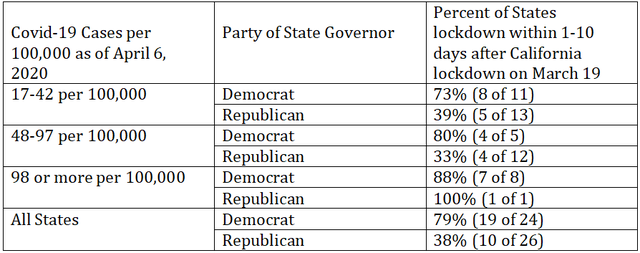要生命还是生意?!——居家令下的美国

(图源Getty Pictures)
为什么各国政府要强制居家隔离呢?
其实流行病学理论早就为这个问题提供了答案。对于那些可导致严重疾病和患者死亡且易通过人际接触传播的病毒,
· 在人群尚无群体免疫时
· 以及尚无有效疫苗和治疗方法时
主要的防疫措施就是:一、进行病毒和抗体检测以确定人群感染或免疫状态,二、追踪确诊者的密切接触者,三、隔离确诊的感染者。尤其对于一些有传染性的无症状感染者而言,这些措施就更加重要了。然而,当检测试剂不充足或检测结果不准确时,追踪密切接触者和隔离确诊者就会变得十分困难或无法实现,而以上情形正是目前美国多数地区所面临的情况。美国的防疫工作现在只剩下了最后的选项,即广泛地限制人与人之间的接触。既然传染病是由人际接触传播的,那么停止接触,就能终止新的感染,然后去治疗那些出现了症状的感染者,而对于无症状感染者,则只能希望他们能获得免疫力并且不具有传染性。
那么强制居家隔离是否有必要呢?绝大部分美国公共卫生官员会说“有必要”,并认为这种隔离应该延续几个月的时间。然而,由于其对社会经济极端且持久的影响,也难怪有人要对其提出质疑,认为这不够明智;尽管这些人也同时承认,居家隔离确实控制了疾病传播速度。无可争议的是,居家隔离既需要代价也具有好处;不过美国社会如今面对的分歧却在于,如何用生命和美元来衡量这种代价和好处。
封锁是如何由公共卫生措施变成政治决策的?
在美国确诊第一例新冠病毒感染者后,政党就参与到新冠病毒的讨论之中。共和党对民主党、右翼对左翼的政治分歧,从各州延迟采取封锁措施的等待时间中即可见一斑(第一道封锁令由加州于2020年3月19日颁布)。如下表所示,无论截至2020年4月6日各州新冠病例数究竟有多少,拥有共和党州长的州,比拥有民主党州长的州,采取封锁措施的速度要慢。

很多时候,共和党的州长们效仿特朗普总统,并不认真对待新冠疫情。甚至在这种传染病发展到无法忽视的地步时,右翼媒体仍在辩称,新冠病毒会像流感一样,不加干预便会消失。
现如今,美国不少执行封锁措施的州已经在计划重新开放了。另有八个州至今未采取任何隔离措施,而这些州都是共和党执政州。那些执行了居家隔离的州,目前有七个正计划在限制人际接触的前提下实行重新开放。其中有一个州—乔治亚州,由共和党执政,4月3日才实施的居家隔离,4月24日就放开了对健身房、发廊、美甲沙龙、保龄球馆和纹身店的限制,并于4月27日起允许在保持社交距离的条件下到餐馆就餐,重新开放电影院和保龄球馆。
居家隔离是否遏制了病毒在美国的传播?
我们有充分的理由相信流行学的观点,即如果人们都呆在家里,随着时间推移,新的感染人数就会减少,因为传染病的病原体是在感染者和易感人群发生接触(日常和/或亲密接触)时传播的。如果人们能够遵照指示行事,则居家隔离切实是一种缓慢但有效的阻止病毒传播的手段。
不过,现在判断居家隔离多么有效还为时过早,因为很快美国就会有很多州同世界上不少国家一样,放松对自我隔离的要求。乔治亚州很快就将认识到放松接触限制是否会显著影响新发病例的数量。瑞典最终会清楚,在缺少居家令的制约下,仅依靠一种强调责任感的文化传统来保证人们的社交距离,能否避免疫情死灰复燃。另外我们最近了解到,新加坡早先通过加强检测和病例追踪,即使没有居家令也做得很好,然而近期在流动务工人员中发现的多个新冠病例,给该国带来了病毒持续传播的威胁。
现在,我们不可能通过一个对照实验来考察那些有居家令的地方,若当初没有执行居家隔离会发生些什么。当然,我们可以比较实施了不同疫情控制政策的国家防控的效果,只是想要在没有偏倚的情况下进行这种比较也非常困难。美国加州作为在2020年3月19日第一个强制实施居家隔离的州,其经验具有启示性,但仍不具备决定性意义。下图是自加州正式确诊第一例新冠病例以来每日新发病例的曲线图(我们现在知道加州第一例新冠死亡病例发生在2020年2月6日),图中蓝色实线显示了加州地区每日报告的新发新冠病例数。

该图显示,加州新发病例数从2020年4月4日开始偏离了指数曲线(红色曲线),此时约为居家令实施后的第16天。目前这被解释为一种指标,表明疫情曲线正在变平,即每日新发病例数量已达到最高水平。我们不知道这个数字还将维持多久,也不知道若人们能继续遵守居家令,这个数字会在多久之后开始下降。
为什么在美国会出现抵制封锁的现象?
2020年4月中旬,在密歇根州、俄亥俄州、明尼苏达州和北卡罗来纳州的州议会大厦前,发生了反对居家隔离的抗议活动,其中一些活动得到了特朗普总统的支持。下图是密歇根州兰辛市抗议活动的照片。

(Getty Pictures)
针对居家令的抗议活动在美国极右势力中最为强烈,但这还不是故事的全部。事实上许多美国人的积蓄很少,信用卡和学生贷款的债务堆积如山。调查显示,17%的美国家庭无法支付400美元的意外开支。这意味着对大部分美国人来说,经济封锁就是一场灾难。失业,政府提供的微薄失业补助,以及被疫情削弱的家庭支持网络,这都意味着疫情已使许多美国人陷入了贫困。
经济vs公众健康?
美国无论在过去还是当下,都没有为这场灾难做好准备。如果我们从一开始就把新冠病毒当作紧急情况来对待,我们的公众健康和经济就不会受到如此严重的损害。我们反应迟了!其中一部分原因是,在至少六个星期的时间里,特朗普和他的盟友们无视病毒的威胁。美国始终缺少真正的全国性政策以及领导能力,大部分的治理责任都被交给了地方政府,而地方政府不得不在公众健康(检测试剂还不足)与迫使许多人陷入贫困的经济压力之间谋求平衡,而能够依赖的仅仅是少量的公共资金。美国那依赖捐赠的“食物银行”几乎不能满足越来越多的失业者对食品的需求。
现在我们面前的所有选项都充满风险。我们可以在控制社交距离的条件下重启经济,但可能会在一些地区经历第二轮疫情打击。我们可以延长居家令,但付出的代价是高涨的失业水平和许多小企业的永久关闭。我们还可以尝试将缓慢的经济重启计划与更严格的病毒检测和病例追踪措施相结合。事实上,我们将在美国的不同地区尝试以上所有的选项。美国应对新冠疫情的故事终将由各地方政府及其施政,以及公众反应来书写。因为这个国家被政治割裂了,当前我们正要进入2020年的选举周期,在特朗普总统离任或连任之前,这个国家都不太可能制定出真正的国家应对政策了。
作者简介:
Wiley博士是加州大学旧金山分校(University of California San Francisco)医学院卫生政策研究所(Institute for Health Policy Studies)的客座教授。在过去的三年里,他每年都在湖南省一所护理院校教授三个月的研究设计和统计学。
译者简介:
周雯娟 中南大学文学与新闻传播学院副教授
文稿编校 | 乔泓瑞 陈奕丰
网络编辑 | 周泓 戴斌
文稿审核 | 易龙
英文原稿:
Stay-At-Home Orders in America: Acceptance and Resistance
A. Why do governments impose stay-at-home rules?
The theory of epidemics of contagious diseases provides a ready answer to this question. For viruses that can cause serious illness and death and are readily transmitted by person-to-person contact,
· in populations with no herd immunity,
· and in the absence of effective vaccines and treatments,
the main public health tools are antibody and virus testing to determine infection or immune status, tracing the contacts of infected persons, and isolation of those infected. This is especially important if some people who are infected and infectious show no overt symptoms. When testing is inaccurate or unavailable, contact tracing and isolation are difficult or impossible. This is the case in most places in the United States at present. That leaves public health with but one alternative: limit the amount of person-to-person contact in general. Epidemics are driven by contact. Stop contact and you will stop new infections. Then you can deal with already infected people who progress to illness and hope that those who don’t become sick are immune and not infectious.
Are stay-at-home orders necessary? Most American public health officials say “yes” and most believe that they need to continue for several months. But the impact on economic activity is extreme and possibly long-lasting. It is no wonder that some people question the wisdom of these limits, even as they acknowledge that stay-at-home orders control the rate of disease transmission. That there are costs and benefits to a stay-at-home order is not debatable. However, there are disagreements about how to value the costs and benefits in terms of lives and dollars.
B. How did lockdowns become political rather than public health decisions?
Politics entered discussions about COVID-19 in America after the first American case. The impact of political divisions --- Republican versus Democrat, right versus left --- shows in the number of days elapsed starting from the first lockdown (California on March 19) that states waited to impose lockdowns. As the table below shows, states with Republican governors were slower to lockdown than states with Democratic governors, regardless of the number of COVID-19 infections as of April 6.

In many cases, Republican state governors followed Trump’s lead in not taking the epidemic seriously. Until the epidemic became too big to ignore, right-wing media kept arguing that Covid-19 was like the flu and would go away without intervention.
Now some states are making plans to reopen. Eight states never imposed stay-at-home orders, all of them headed by Republican governors. Of those states that had stay-at-home orders, seven are planning to reopen under various restrictions that attempt to limit personal contact. One of these, Georgia, headed by a Republican governor, began its stay-at-home order late, on April 3, and opened gyms, hair and nail salons, bowling alleys and tattoo parlors on April 24. Starting April 27, restaurants can have dine-in service with social distancing, and movie theaters and bowling alleys will reopen.
C. Have stay-at-home orders affected the spread of infection in the US?
We have good reason to believe the predictions of epidemic theory that the number of new infections will decrease over time if people stay at home. Epidemics are driven by a type of contact (casual and/or intimate) between infected persons and susceptible persons that transmits the disease agent. Stay-at-home orders are a blunt, but effective device to prevent transmission if people obey the orders.
It is too early to say how effective stay-at-home orders are. There are soon to be many states and several countries that reduce self-isolation. Georgia will find out soon if relaxing limits on contact have a noticeable impact on the rate of new cases. Sweden will discover eventually if reliance of on a culture of responsibility to keep social distance without a stay-at-home order avoids a resurgence of cases. And we have learned recently that Singapore did well with testing and case tracing and no stay-at-home order until infections among migrant workers posed the threat of continued spread of infection.
We cannot conduct a controlled experiment to determine what would have happened without stay-at-home orders where they are now in place. Instead, we rely on comparisons between populations whose governments impose different policies to contain the epidemic. And those comparisons are very difficult to make without bias. The California experience, as the first state to impose a stay-at-home order on March 19, 2020, is suggestive but not conclusive. Here is the graph of the daily number of cases since the first officially recognized case of Covid-19 in California. (We now know the first Covid-19 death in California occurred on February 6, 2020).

This graph shows that the number of cases began to diverge from the exponential curve (the red line) on April 4, about 16 days after the stay-at-home order. This is currently interpreted as an indicator that the curve of the epidemic is flattening---- that the number of new cases has reached a maximum. We don’t know how long the number will stay at this level and how soon it will begin to decline if stay-at-home orders are obeyed.
D. Why is there resistance to lockdowns in America?
In mid-April protests against stay-at-home orders happened in the state capitols of Michigan, Ohio, Minnesota, and North Carolina, some with support from President Trump. Here is a photo of the protest in Lansing Michigan:

(Getty Pictures)
Protests against stay-at-home orders are most vocal among the extreme right wing,
but that is not the whole story. Many Americans have very little in savings and mountains of debt from credit cards and student loans. Surveys suggest that 17% of
American families cannot manage a surprise expense of $400. This means that a lockdown of the economy is a disaster for a large sector of the American population. Loss of work coupled with a meager unemployment pay from the government and weakened family support networks means that the epidemic has pushed many into poverty.
E. Economy versus Public Health?
America was not and is not prepared for this disaster. If we had treated Covid-19 as the emergency it is from the beginning, our population’s health and our economy would not be so badly damaged. We were late, in part due to 6 weeks of dismissing the threat by Trump and his allies. We have no real national policy or leadership with most of the responsibility delegated to state governments who have to balance the public’s health (with inadequate testing) against economic pressures that have forced many of our citizens into poverty and dependence on small grants of public funds. Our food banks, which depend on donations, can barely meet the demands for food from increasing numbers persons out of work.
All choices now have risks. We can open the economy, depending on “social distancing”, and perhaps experience a second wave of infections in some regions. We can keep stay-at-home orders at the cost of increasing unemployment and permanent closure of many small businesses. We can try to combine slow reopening with more intense testing and case tracing. In fact, we will do all of these things but in different areas of the country. The story of America’s response will be written by state and regional governments and by the public responses to their policies. Because the country is divided politically and we are entering the 2020 election cycle, it is very unlikely that we will evolve a true national policy before Trump leaves office or is re-elected.
James A. Wiley, PhD
Dr. Wiley is Adjunct Professor at the Institute for Health Policy Studies
in the School of Medicine, University of California, San Francisco. He has taught research design and statistics at a nursing school in Hunan Province for three months per year during the last three years.


















评论